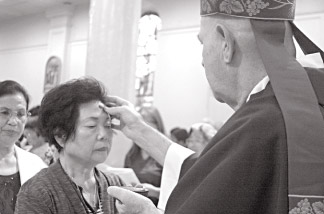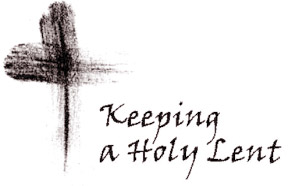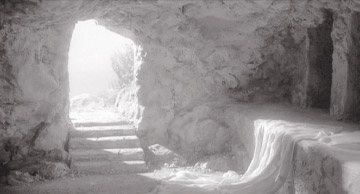|
Christian Perspectives
Season of Lent - Part II
E Weerapperuma
The ash used on Ash Wednesday ceremony is blessed according to
various rites proper to each liturgical tradition, sometimes involving
the use of Holy Water. In some churches, they are mixed with a small
amount of water or olive oil which serves as a fixative.
The presiding priest at the Holy Mass, blesses, sprinkles holy water
over the ashes gathered after the burning of dried palm leaves and then
ceremonially apply them with the Sign of the Cross on the forehead of
each believer attending the service, repeating the words found in the
book of Genesis.
“Remember that thou art dust, and to dust thou shalt return.” (Gen
3:19) or “Turn away from sin and be faithful to the Gospel”. (Mark 1:15)
or “Repent, and believe the Good News” This is a reminder to all; ‘we
are born to die’; ‘return to ash’, someday, the day decided by God, Our
Father and Creator. As a part of the liturgy of the day, penitential
psalm 50 or 51 is either read or sung.
|

Ash Wednesday |
The liturgical imposition of ashes on Ash Wednesday is sacramental
and not a sacrament.
Ashes have a religious significance to the human race from the times
of the Old Testament.
Ashes are used as an external expression of mourn and repentance over
the sins committed offending God the Creator, who is the prime cause of
humanity.
It is a symbolic expression of penance. This rite or ritual reminds
the adherents, the importance of doing penance and the season of Lent
creates the milieu necessary for deep meditation.
In the synoptic Gospels, we read Sts. Matthew, Mark and Luke stating
the fact that Jesus Christ prior to the beginning of His Three Year Long
Public Ministry, spent 40 days in prayer and fasting in the wilderness
enduring the temptations of Satan. Thus, this period turns to be a time
of prayer, fasting and abstinence to all who follow in the steps of
Jesus.
The placing of ash over the foreheads of adherents echoes the ancient
tradition of throwing ashes over one's head as a sign of mourn and
repentance before God Almighty.
Ashes are to express mourn: In the book of Job, we find an expression
of one's repentance. In Job 42: 3-6, Job tells God: “I have heard of
thee by the hearing of the ear: but now mine eye seeth thee. The other
eye wandereth of its own accord.

Wherefore I abhor myself, and repent in dust and ashes. “Prophet
Jeremiah calls for repentance this way: “O daughter of my people, gird
on sackcloth, roll in the ashes” (Jer 6:26).The prophet Daniel pleaded
with God this way: “I turned to the Lord God, pleading in earnest
prayer, with fasting, sackcloth and ashes” (Daniel 9:3).
Just prior to the New Testament period, the rebels fighting for
Jewish independence, the Maccabees, prepared for battle using ashes:
“That day they fasted and wore sackcloth; they sprinkled ashes on their
heads and tore their clothes”. (1 Maccabees 3:47; see also 4:39).
Numbers 19:9 and 17; Jonah 3:6; Matthew 11:21; Luke 10:13 and Hebrews
9:13 are some other examples showing how the People of God expressed
repentance or mourn over their sins.
In England during the Victorian period, it is on record that the
theatres of the day refrained costumed shows on Ash Wednesday.
The Eastern Orthodox Church instead of observing Ash Wednesday;
begins Great Lent on Clean Monday. Yet a small group of Orthodox
Christians follow the Western Rite and observe Ash Wednesday, often on a
different day which determined on the Orthodox calculation of
Easter,(Pascha) and it may well occur later than the Western observance
of Easter.
The earliest date Ash Wednesday can occur is February 4, in a common
year with Easter on March 22, which happened in the years1573, 1668,
1761 and 1818 and will next occur in the year 2285.
The latest date is March 10th (when Easter Day falls on April 25).And
this occurred in the year 1546, 1641, 1736, 1886 and 1943 and will next
occur in the year 2038.
Ash Wednesday has never occurred on Leap Year Day (February 29), and
it will not occur as such until 2096. The only other years of the third
millennium that will have Ash Wednesday on February 29 are year 2468,
2688, 2840 and 2992.
Ash Wednesday falls on February 29 only if Easter is on April 15 in a
leap year.
* 2012 – February 22
* 2013 – February 13
* 2014 – March 5
* 2015 – February 18
* 2016 – February 10
* 2017 – March 1
* 2018 – February 14
* 2019 – March 6
* 2020 – February 26
* 2021 – February 17
* 2022 – March 2
* 2023 – February 22
(Concluded)
Christian belief in Resurrection
Christian belief in the Resurrection of Jesus is that Jesus returned
to bodily life on the Sunday following the Friday on which he was
executed by crucifixion. It is a central tenet of Christian faith and
theology and part of the Nicene Creed: “On the third day he rose again
in fulfillment of the Scriptures”.
In the New Testament, after the Romans crucified Jesus, he was buried
in a new tomb, but God raised him from the dead and he appeared to many
people over a span of forty days before his ascension to Heaven.
Christians celebrate the Resurrection of Jesus on Easter Sunday, the
third day after Good Friday, the day of his crucifixion. Easter's date
corresponds roughly with Passover, the Jewish observance associated with
the Exodus.
The Resurrection story appears in more than five locations in the
Bible. In several episodes in the Canonical Gospels, Jesus foretells his
coming death and Resurrection, which he states is the plan of God the
Father. Christians view the Resurrection of Jesus as part of the plan of
salvation and redemption. There are other accounts of the death of
Jesus, notably in the Jewish and Islamic traditions. Not all of these
accounts include the Resurrection.
Skeptical scholars have questioned the historicity of the
Resurrection story for centuries, for example, “19th and early 20th
Century biblical scholarship dismissed Resurrection narratives as late,
legendary accounts.” Some contemporary scholars still express doubts
about the historicity of the Resurrection accounts and have debated
their origin, and others consider that the biblical accounts of Jesus’
Resurrection were derived from the experiences of Jesus’ followers and
of Apostle Paul.
In the New Testament there are three groups of events that surround
the death and Resurrection of Jesus, Crucifixion and burial, wherein
Jesus is placed in a new tomb following his death, discovery of the
empty tomb and the Resurrection appearances.
The New Testament does not include an account of the ‘moment of
Resurrection’ and in the Eastern Church, icons do not depict that moment
but show the Myrrhbearers and depict scenes of salvation.
Burial
All four Gospels state that, on the evening of the crucifixion,
Joseph of Arimathea asked Pilate for the body of Jesus, and that, after
Pilate granted his request, he wrapped Jesus’ body in a linen cloth and
laid it in a tomb. This was in accordance with Mosaic Law, which stated
that a person hanged on a tree must not be allowed to remain there at
night, but should be buried before sundown.
In Matthew, Joseph was identified as ‘also a disciple of Jesus’, in
Mark he was identified as “a respected member of the council (Sanhedrin)
who was also himself looking for the Kingdom of God,” in Luke he was
identified as “a member of the council, good and righteous, who did not
consent to their purpose or deed, and who was looking for the Kingdom of
God” and in John he was identified as “a disciple of Jesus”.

The Gospel of Mark states that when Joseph asked for Jesus’ body,
Pilate was shocked that Jesus was already dead and he summoned a
centurion to confirm this before dispatching the body to Joseph. John
recorded that Joseph was assisted in the burial process by Nicodemus,
who brought a mixture of myrh and aloes and included these spices in the
burial cloth as per Jewish customs. The following are further New
Testament comments on the death of Christ and Resurrection after his
time in the tomb:
The apostle Peter delivers a sermon fifty days after the Resurrection
in which he states: “Brothers, I can tell you confidently that the
patriarch David died and was buried, and his tomb is here to this day.
But he was a prophet and knew that God had promised him on oath that he
would place one of his descendants on his throne. Seeing what was ahead,
he spoke of the Resurrection of the Christ, that he was not abandoned to
the grave, nor did his body see decay. God has raised this Jesus to life
and we are all witnesses of the fact.” (Acts 2:29-31).
As written in the Book of Revelation: “When I saw him, I fell at his
feet as though dead. Then he placed his right hand on me and said: “Do
not be afraid. I am the First and the Last. I am the Living One, I was
dead (Greek egonomen nekros), and behold I am alive for ever and ever!
And I hold the keys of death and Hades.” (Rev 1:17-18).
1 Peter also states: “It is better if it is God's will, to suffer for
doing good than for doing evil. For Christ died for sins once for all,
the righteous for the unrighteous, to bring you to God. He was put to
death in the body but made alive by the Spirit, through whom also he
went and preached to the spirits in prison.” (ie He descended into Hades
after his death) (1 Pet 3:18-20) which describes Jesus as preaching to
the ‘spirits in prison who disobeyed long ago.’ This passage, along with
the phrase in 1 Peter that God did “not leave his soul in Hades,” (Acts
2:31) is the theological basis behind the statement “He descended into
Hades” in the Apostles’ Creed. The death state of Christ was considered
by the theologians such as Thomas Aquinas and related in traditions such
as the Harrowing of Hell.
Although no single Gospel gives an inclusive or definitive account of
the Resurrection of Jesus or his appearances, there are four points at
which all four Gospels converge:
? The linking of the empty tomb tradition and the visit of the women
on “the first day of the week,”
? That the risen Jesus chose first to appear to women (or a woman)
and to commission them (her) to proclaim this most important fact to the
disciples, including Peter and the other apostles,
? The prominence of Mary Magdalene,
? Attention to the stone that had closed the tomb. Variants have to
do with the precise time the women visited the tomb, the number and
identity of the women, the purpose of their visit, the appearance of the
messenger(s) – angelic or human, their message to the women and the
response of the women.
? All four Gospels report that women were the ones to find the tomb
of Jesus empty, although the number varies from one (Mary Magdalene) to
an unspecified number.
According to Mark and Luke, the announcement of Jesus’ Resurrection
was first made to women. According to Matthew and John, Jesus actually
appeared first to women (in Mark 16:9 and John 20:14 to Mary Magdalene
alone). “Whereas others found woman not qualified or authorized to teach
the four Gospels have it that the risen Christ commissioned women to
teach men, including Peter and the other apostles, the Resurrection,
foundation of Christianity.”
In the Gospels, especially the synoptics, women play a central role
as eyewitness at Jesus’ death, entombment and in the discovery of the
empty tomb. All three synoptics repeatedly make women the subject of
verbs of seeing and clearly presenting them as eyewitnesses.
Resurrection appearances of Jesus
After the discovery of the empty tomb, the Gospels indicate that
Jesus made a series of appearances to the disciples. These include the
appearance to the disciples in the upper room, where Thomas did not
believe until he was invited to put his finger into the holes in Jesus’
hands and side (Jn 20:24-29) the Road to Emmaus appearance (Lk 24:13-32)
and beside the Sea of Galilee to encourage Peter to serve his followers
(Jn 21:1-23). His final appearance is reported as being forty days after
the Resurrection when he ascended into heaven (Lk 24:44-49) where he
remains with God the Father and God the Holy Spirit until the Second
Coming of Christ.
Soon after, on the road to Damascus, Paul of Tarsus converted to
Christianity based on a vision of Jesus and later, became one of
Christianity’s foremost missionaries and theologians.
Source: Internet
Pope condemns gay marriage in speech to US bishops
Pope Benedict XVI on Friday condemned gay marriage in a speech to
bishops from the United States after Maryland last week became the
eighth US state to legalise same-sex unions.
“Sexual differences cannot be dismissed as irrelevant to the
definition of marriage,” the pope said, warning against “the powerful
political and cultural currents seeking to alter the legal definition of
marriage”.
“Marriage and the family are institutions that must be promoted and
defended from every possible misrepresentation of their true nature.” He
also said bishops could not overlook “the serious pastoral problem
presented by the widespread practice of cohabitation”.
“The contemporary crisis of marriage and the family... has led to
grave societal problems bearing an immense human and economic cost,” he
added.
Benedict XVI has frequently warned against liberal family values in
veiled references to homosexual marriage and adoptions by gay couples,
and the Catholic Church often condemns countries that recognise gay
rights.
AFP
‘Miracle School of Healing and Wholeness’
Ken de Joodt
Many Christians in Sri Lanka were privileged and honoured to welcome
Rev. Dr. V. Dillkumar, Founder and Senior Overseeing Pastor of King's
Revival Church (International) Ministries, Dubai - when the ‘Miracle
School for Healing and Wholeness’ was successfully conducted at the
Mount Lavinia Hotel from February 9 to 11.
This teaching and impartation facet of King's Revival Church (Intl),
conducted a similar school previously in 2006 from May 18 to 20 at the
Bishop's College Auditorium, which was filled to capacity with a fine
blend of elders and youth.
On this occasion too, in collaboration with its branch church ‘King's
Revival Church, Mount Lavinia’, headed by Senior Pastor Jerome Fernando,
over one thousand participants from a cross-section of different church
denominations, assembled for three days of learning.
Rev. Dr. V. Dillkumar, had the undivided attention of the listeners.
Rev. Dr. V. Dillkumar, taught deep Biblical truths in the Love and
Power of the Holy Spirit and gave the entire audience a deep insight
into the working of Miracles by the Power of the Holy Spirit, Baptism
and Anointing, Gifts and Fruit of the Holy Spirit, plus the truth and
candid facts of ‘Character in Ministry’, great testimonies and praise
reports of signs, wonders and miracles.
In a brief ‘run-up’ to his startling career, Dr. Dillkumar arrived in
the UAE in 1983 as a Chartered Engineer with accreditation from the USA,
UK, Australia and Sri Lanka to start work with a large Consortium.
While working in Dubai, he surrendered his life to Jesus Christ in
1984.
Sri Lanka has been honoured and blessed by the reverential presence
of Rev. Dr. V. Dillkumar, who is currently featured in ten famous
Christian TV Stations - TBN Europe, Inspiration TV, GOD TV, Grace TV,
CTS TV, Holy God TV, Revelation, Faith and Rainbow TV - who telecasts
his programme called ‘Miracle Moments'.
These programmes carry the Gospel of Christ to millions of people in
many nations. |



